Hype, Infra, Adoption: Will x402 Make it?
Key Takeaways
- In the crypto industry, most new concepts go through three phases: hype, infrastructure, and adoption. However, most fail to transition successfully from the hype phase to the infrastructure phase and lose market attention.
- x402 is a protocol developed by Coinbase for AI agent payments. It enables AI agents to easily make payments and access paid resources through blockchain without human intervention.
- Judging from the recent surge in tokens related to x402, it has entered the hype phase. However, what differentiates x402 from other typical crypto topics is that major companies such as Cloudflare, Google Cloud, and Anthropic are actively adopting it, which means the infrastructure phase is progressing rapidly.
- Considering the potential of agentic commerce, x402 is expected to have a high probability of reaching the adoption phase. However, the bottleneck lies in changing consumer psychology and trust structures. According to Accenture, the biggest obstacle to the mass adoption of agentic commerce is that consumers do not trust AI agents.
- Nevertheless, Gartner predicts that by 2030, the transaction volume controlled by AI agents will reach $30 trillion. Agentic commerce will thus become an inevitable and massive market of the future. This will mark the moment when blockchain, following stablecoins, finds its second global PMF.
1. Hype, Infrastructure, and Adoption Cycle
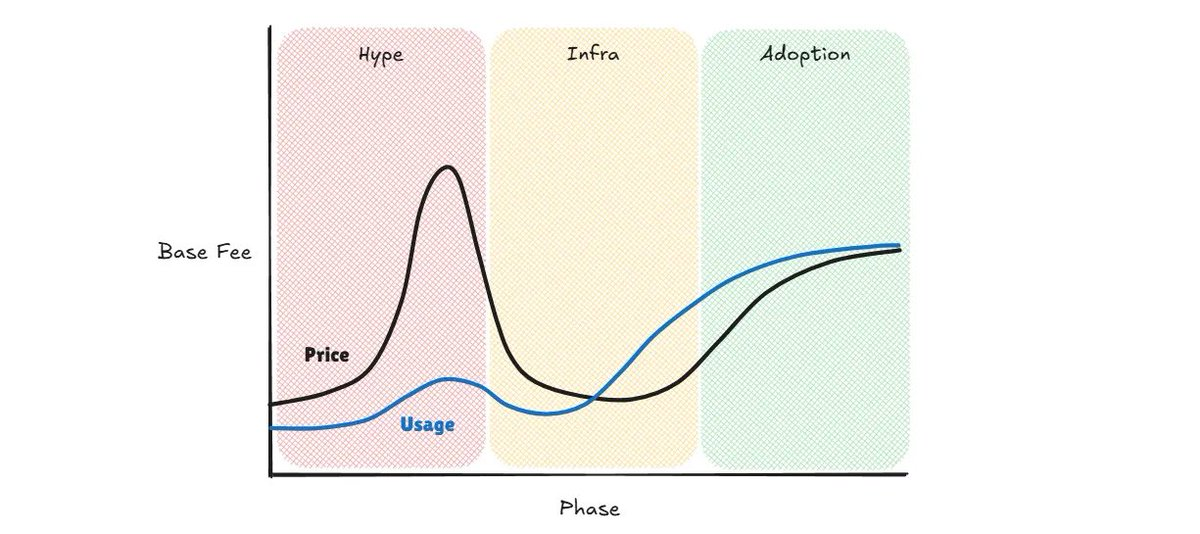
1.1 Until a New Concept Is Adopted
Crypto is a rapidly changing industry. New concepts emerge and disappear in cycles shorter than a few months, and the concentration and disappearance of attention are more extreme than in any other industry. On a larger scale, keywords such as NFT, gaming, metaverse, and modular blockchain have shown such patterns, and on a smaller scale, recent examples like futarchy briefly appeared and quickly faded from market interest.
Because countless new concepts emerge in the crypto industry, there are many hurdles to overcome for a new concept to achieve meaningful adoption. I describe this in three stages:
- Hype Phase: This is when a new concept first gains significant attention. During this stage, existing projects even slightly related to the concept, newly launched small projects, and related meme coins often surge by tens or even hundreds of percent. If the concept transitions successfully to the next phase, prices may hold, but in most cases, they collapse within weeks or months, and projects disappear.
- Infrastructure Phase: Once the potential and relevance of the new concept are proven, builders begin developing meaningful products based on it. Product building takes a long time—from several months to over a year—so vague or weak concepts often die in this stage. However, if the concept is truly meaningful, this is when it maintains steady interest, creates real use cases, and the sector gradually grows.
- Adoption Phase: Congratulations if it gets this far! In crypto, very few concepts have reached the adoption phase—examples include AMMs, CLOBs, lending protocols, staking-related protocols, and stablecoins. A concept that reaches this stage has proven its PMF, so new protocols continue to appear over time, and many users actively participate.
1.2 Examples in Crypto Sectors
Then what is the current state of the topics that are receiving intense attention on CT lately?
- Futarchy: As mentioned above, futarchy entered the hype phase once when Vitalik mentioned it in the past, then faded away, and recently entered another hype phase with Solana’s ICO platform. However, it quickly lost attention within a few weeks. The reason is that futarchy involves an enormous governance discourse, making it a concept difficult to achieve mass adoption without multiple generational shifts in human society.
- Decentralized Energy: Decentralized energy entered the hype phase around last year when many companies received Tier 1 VC investments. Recently, Daylight received another $75 million investment from Framework and a16zcrypto, temporarily sparking hype again, but market interest did not sustain. This is because, as a sector requiring physical infrastructure, the infrastructure phase of decentralized energy inevitably takes a long time.
- Robotics: Robotics follows a similar pattern. While crypto x AI was gaining attention, the crypto x robotics project Openmind raised $20M from Pantera and others, igniting interest in the robotics sector. Prices of many small to mid-sized projects and meme tokens surged, but it will still take time to reach the adoption phase. However, given the immense potential of the crypto x robotics concept, many builders including Openmind are actively developing products.
Looking at these examples, the path from a new concept to adoption in the crypto industry seems extremely challenging.
However, a concept that has recently been gaining significant attention on CT, called x402, appears to have the potential to reach the adoption phase quickly. What makes x402 different?
2. Will x402 Make it?
2.1 Overview of x402
x402 is an open payment protocol developed by Coinbase, designed to allow AI agents to perform payments and complete transactions autonomously without human intervention. x402 enables AI agents to pay for services using stablecoins across multiple blockchains and offers the advantage of instant settlement without complex processes such as account creation, subscriptions, or API keys.
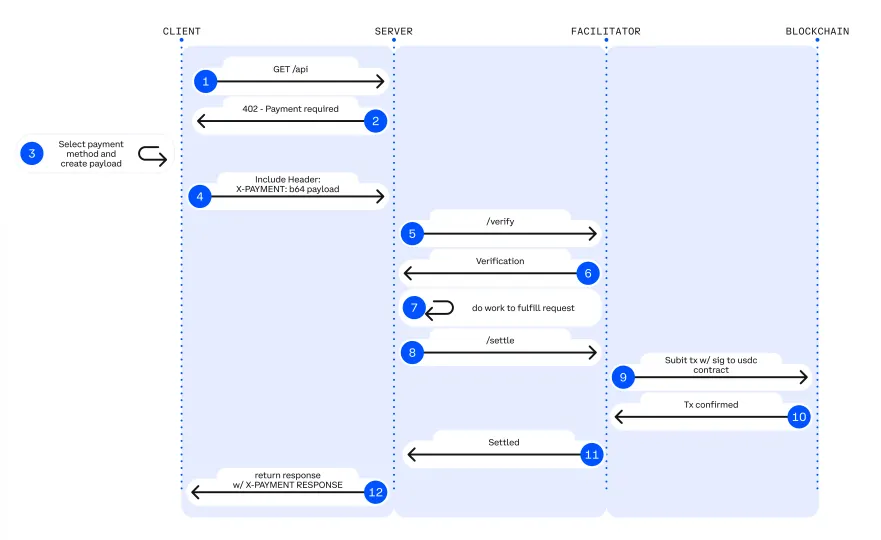
Source: Coinbase
HTTP 402 is a status code meaning “Payment Required,” but it has rarely been used for a long time. x402 utilizes HTTP 402 so that when an AI agent sends an API call, the server returns an HTTP 402 code indicating that payment is required. The AI agent then recognizes this response and pays the required amount in stablecoins. The detailed process is as follows:
- When an AI agent attempts to access a paid service such as news articles, APIs, or data, the server returns an HTTP 402 Payment Required status code. This response does not merely state “payment required” but also includes information such as the payment method, payment amount, and payee (wallet address).
- Based on the information provided by the server, the AI agent generates a transaction for the specified amount, adds a digital signature, and sends it back to the server.
- The server passes this to a Facilitator, who verifies the payment and processes it on the blockchain.
- Once the payment is complete, the server grants the AI agent access to the service.
x402 holds significance beyond simply providing a standard that enables AI agents to make payments. Since payments are made using blockchain-based stablecoins, it enables micropayments that were previously impossible, allowing AI agents to call APIs or pay for services in real time according to usage. x402 also allows human users to bypass complex processes such as API key management or account creation, enabling micropayment-based access to content.
2.2 Hype Phase
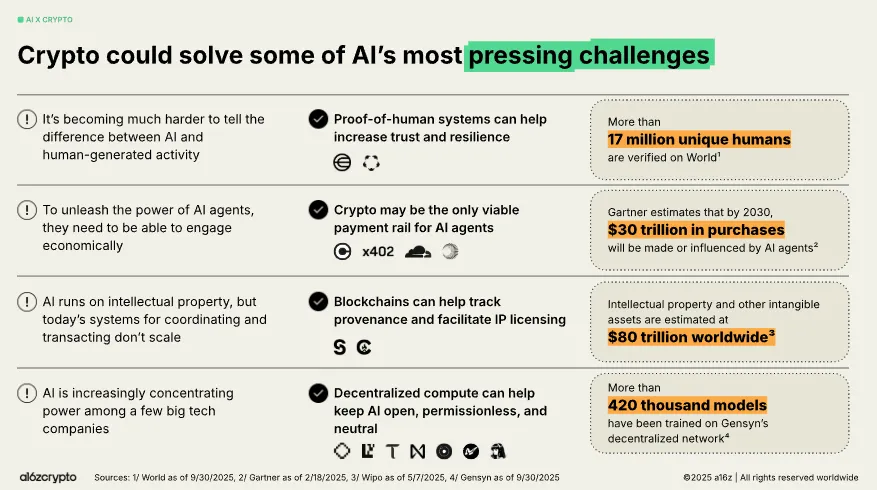
Source: a16zcrypto
x402 was introduced in May 2025 and received moderate attention at first. However, it began to gain significant traction after being mentioned in a16zcrypto’s “State of Crypto 2025: The year crypto went mainstream” report. According to Gartner, the agentic commerce market is expected to reach $30 trillion by 2030, and a16z stated that x402 could become the primary payment rail for AI agents.
The clearest sign that x402 has entered the hype phase is the sharp rise in related token prices. For example, $VIRTUAL, which reacts whenever the AI agent narrative resurfaces, rose 40% in just two days, and other related tokens have also seen steep price increases as shown below.
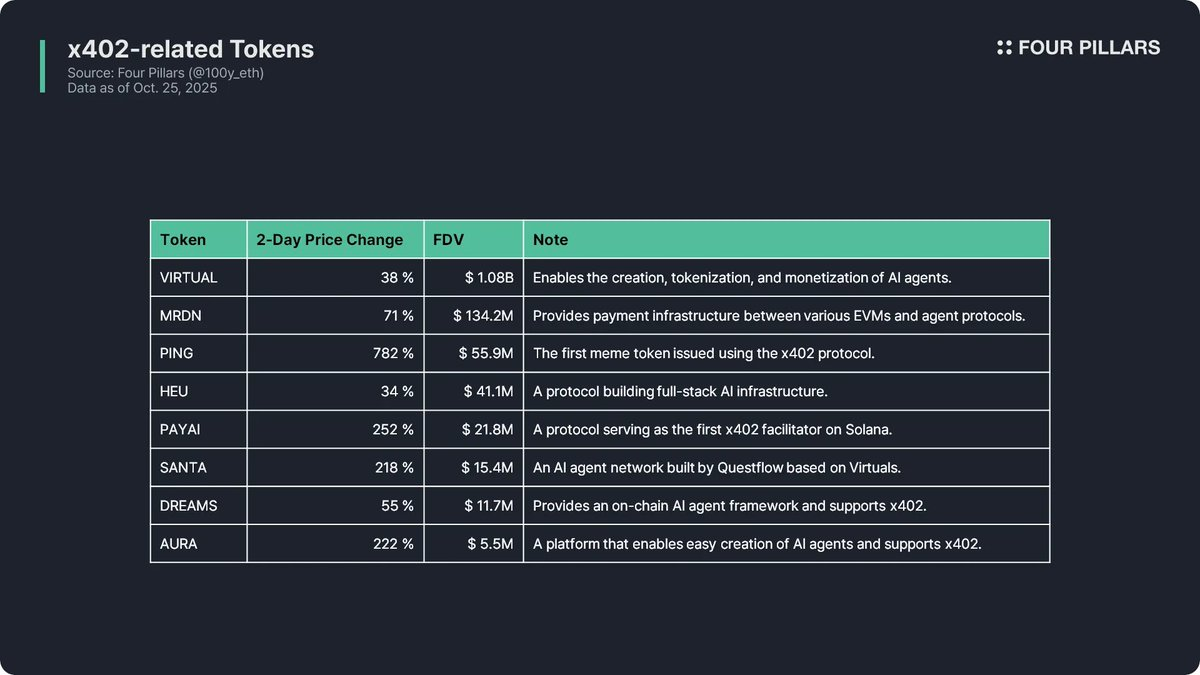
This makes x402 appear to be yet another typical crypto concept—hollow, superficial, and driven purely by hype. Indeed, many new crypto concepts have emerged in this way, causing massive price spikes in small projects and meme tokens before disappearing.
However, what differentiates x402 from other topics is that 1) the theme of AI agent payments is highly relevant not only in crypto but also in the broader AI industry, making it a topic with substantial potential, and 2) numerous Web2 companies are actively paying attention to and adopting x402. These factors indicate that x402 may not remain in the hype phase for long but could transition rapidly into the infrastructure phase.
2.3 Infrastructure Phase
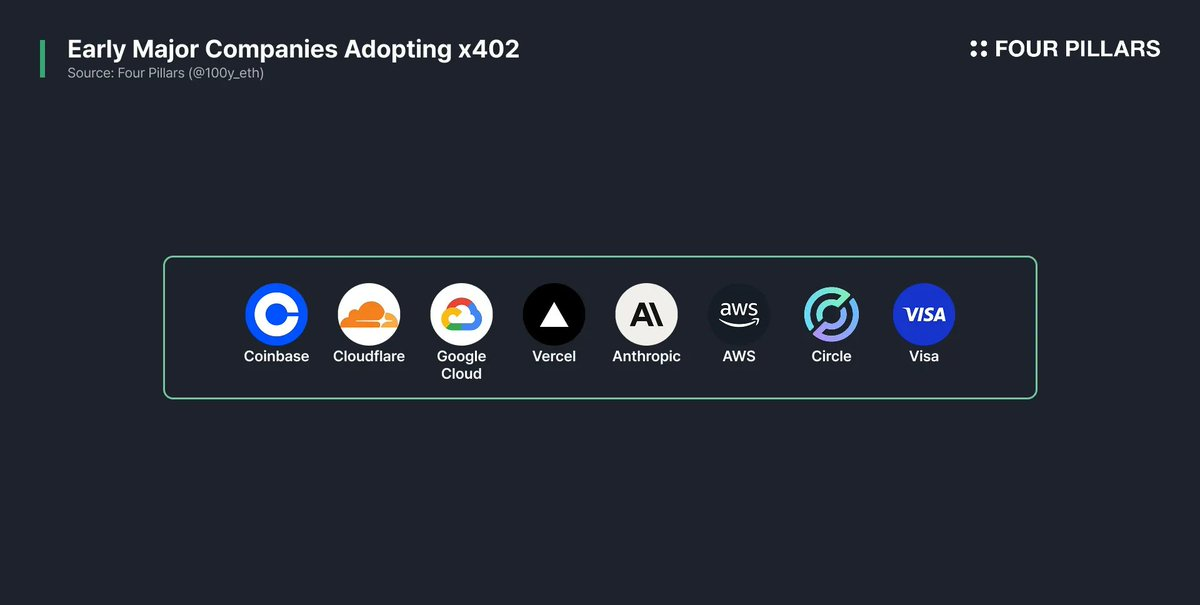
Currently, x402 is in both the hype phase and the infrastructure phase. In fact, even before x402 entered the hype phase, many Web2 and Web3 companies had already been building infrastructure for x402 and actively integrating it into their services. Therefore, it is more accurate to say that x402 started from the infrastructure phase.
What is interesting is that unlike typical crypto narratives, x402 has attracted the attention of major Web2 big tech companies that are actively adopting it.
2.3.1 Cloudflare
Cloudflare is a company that provides internet infrastructure and security solutions. Recently, it has also introduced services such as “Agents SDK,” which allows developers to easily create and deploy AI agents, and “Workers AI,” an environment for running AI model inference.
Cloudflare co-founded the x402 Foundation with Coinbase and has been highly active in the x402 ecosystem. Cloudflare supports x402 in its “Agents SDK” service, enabling AI agents to easily access payments over the internet.
Notably, Cloudflare recently introduced a USD stablecoin called NET Dollar, designed for AI agents. AI agents built with “Agents SDK” are expected to perform agentic commerce using x402 and NET Dollar.
2.3.2 Vercel
Vercel is a cloud platform company that helps developers easily build and deploy web applications quickly. Vercel has recently launched services such as “Vercel AI SDK” and “Vercel MCP,” allowing developers to build and deploy AI agents easily and enabling access to projects through MCP. In September, Vercel released x402-mcp, which allows AI agents to automatically handle payments via x402 when accessing paid APIs or resources through MCP.
2.3.3 Google Cloud
Google Cloud previously introduced A2A, a protocol that enables AI agents to communicate and collaborate with each other. A2A includes an extension called AP2 (Agentic Payments Protocol), which allows agents to make autonomous payments. x402 is integrated into this system, serving as the payment engine that enables actual transactions by AI agents.
2.3.4 Anthropic
Anthropic is a well-known AI company that created the Claude LLM, through which users can build AI agent services. Anthropic also introduced an open-source standard called MCP, a protocol that defines how AI models access external tools and data. Claude MCP supports x402, which allows Claude to automatically handle payments when accessing paid MCP tools.
2.3.5 Visa
Visa, the world’s largest card payment network, recently announced the “Trusted Agent Protocol,” co-developed with Cloudflare. This protocol verifies whether AI requests in agentic commerce are trustworthy and supports payments through x402.
2.3.6 Others
According to Coinbase’s announcement, other companies such as Circle and AWS are also collaborating on x402.
In addition to the companies and protocols adopting x402, developer-friendly tools such as x402scan have recently emerged. This explorer visualizes servers, transactions, and payment flows that utilize x402, allowing users to see which services are making payments through which facilitators and on which networks. As the x402 ecosystem continues to expand, more companies and tools are expected to join and further enrich the ecosystem.
3. Can x402 Reach the Adoption Phase?
3.1 The Challenge of Entering the Adoption Phase
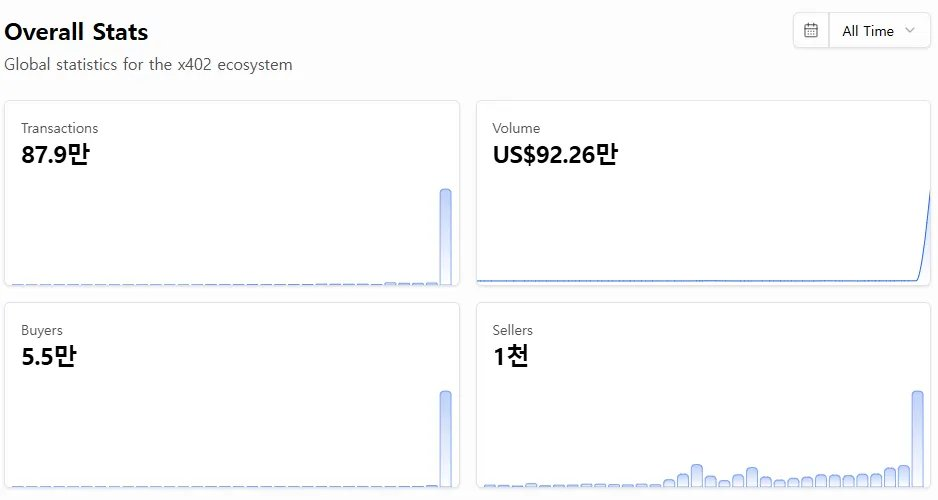
Source: x402scan
Judging from the sharp rise in related token prices and the fact that major companies are adopting x402, it seems that x402 has reached both the hype and infrastructure phases. The remaining question for x402 is whether it can move into the adoption phase.
According to metrics from x402scan, approximately 55K buyers have sent around 879K transactions to about 1K sellers so far. These numbers appear impressive, but the total transaction volume amounts to only about $923K. This indicates that x402 is still far from entering the adoption phase.
3.2 Conditions for Reaching the Adoption Phase
What are the conditions required for x402 to move into the adoption phase? One of the most frequently mentioned factors is consumer psychology and the structure of trust. Even for someone like me writing about x402, I’m comfortable with AI agents making recommendations in commerce, but I still hesitate to fully trust them with my money.
Even the latest LLMs occasionally provide incorrect information or undesired answers, so from a psychological standpoint, it’s hard for consumers to trust AI agents based on such models to handle payments. In fact, according to an Accenture survey of financial institutions, 87% cited customer distrust in AI payments as a problem, and 78% expressed concerns about AI bots making unauthorized payments or being involved in fraud.
The second factor is the state of corporate infrastructure. According to Accenture, 85% of financial institutions reported that their existing legacy systems were not suitable for handling large-scale agentic payments. In particular, the lack of systems to respond to fraudulent transactions in agentic payments was one of the major barriers to entry.
In conclusion, for x402 to move into the adoption phase, companies need to build systems optimized for agentic commerce and cultivate consumer trust in these systems. However, both developing such infrastructure and changing consumer psychology take significant time, so it may take longer than expected for x402 to reach the adoption phase.
3.3 What Does This Mean for the Blockchain Industry?
Gartner projects that by 2030, AI agents will influence $30 trillion in purchases. Although the AI agent payment market is still in its early stages, it is encouraging that x402 appears to be establishing itself as the standard. This aligns with the fact that major IT companies such as Google, Anthropic, and Cloudflare have adopted x402 for AI agent payments.
What can the crypto market expect when x402 becomes more active? One highly probable prediction is that the recent surge in x402-related tokens is unlikely to sustain for long. Since the emergence of the crypto x AI sector, it has gradually evolved into a meaningful concept with several new initiatives, yet most of the smaller project tokens and meme tokens that soared during the initial hype phase have seen disappointing price performance over time.
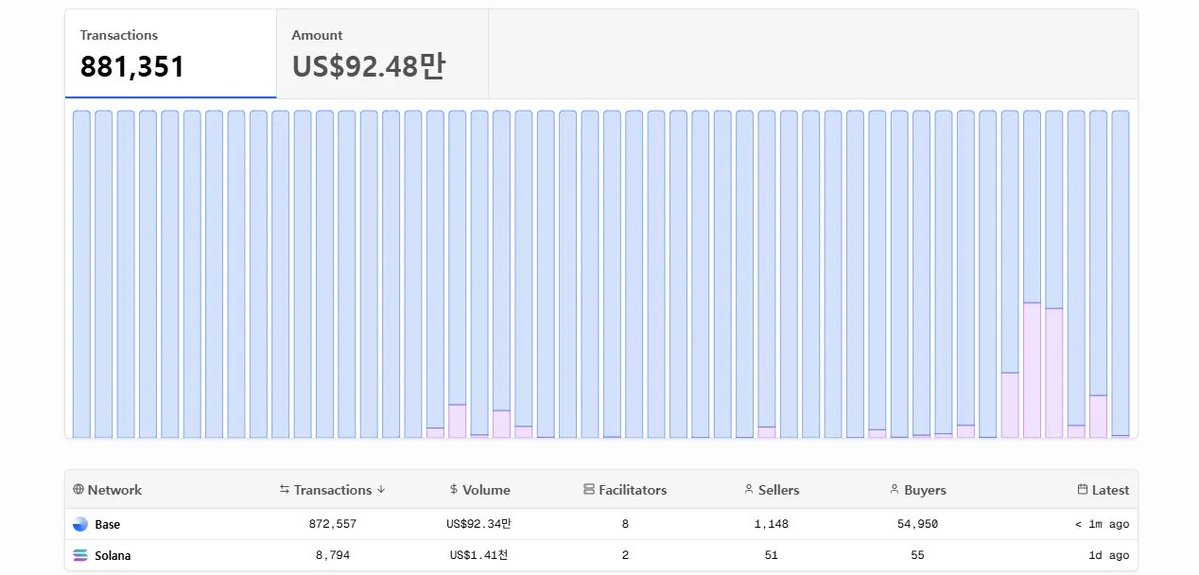
Source: x402scan
One clear value-add that x402 brings to the blockchain industry is that all AI agent payments will be conducted on blockchain networks. Currently, most transactions take place on the Base network, with some occurring on Solana, but x402 is designed to be blockchain-agnostic, meaning it can be used across any network. This implies that as the x402 ecosystem expands, payments will take place across multiple networks—not only Base and Solana—driven by the demand and supply of buyers and sellers.
Agentic commerce represents an inevitable and massive market of the future, and all payments will eventually flow through x402 on the blockchain. This will mark the moment when blockchain, following stablecoins, finds its second global PMF.
Disclaimer:
- This article is reprinted from [100y_eth]. All copyrights belong to the original author [100y_eth]. If there are objections to this reprint, please contact the Gate Learn team, and they will handle it promptly.
- Liability Disclaimer: The views and opinions expressed in this article are solely those of the author and do not constitute any investment advice.
- Translations of the article into other languages are done by the Gate Learn team. Unless mentioned, copying, distributing, or plagiarizing the translated articles is prohibited.
Related Articles

The Future of Cross-Chain Bridges: Full-Chain Interoperability Becomes Inevitable, Liquidity Bridges Will Decline

Solana Need L2s And Appchains?

Sui: How are users leveraging its speed, security, & scalability?

Navigating the Zero Knowledge Landscape

What is Tronscan and How Can You Use it in 2025?
